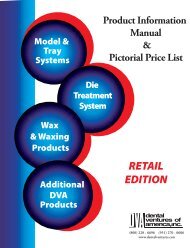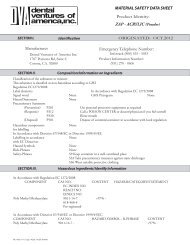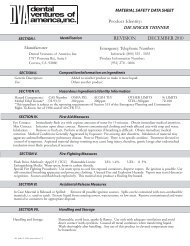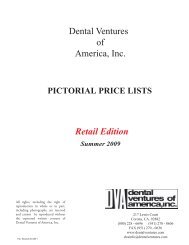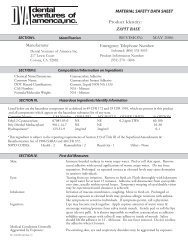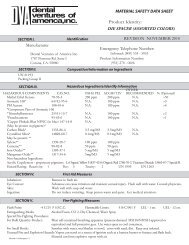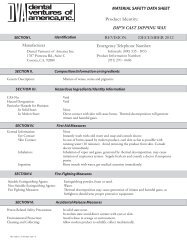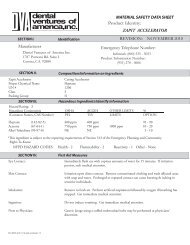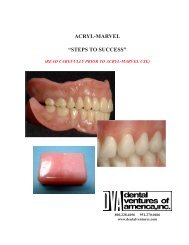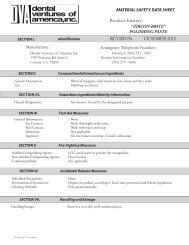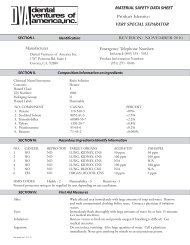zapit tip cleaner 2.11 pg.1.ai - Dental Ventures
zapit tip cleaner 2.11 pg.1.ai - Dental Ventures
zapit tip cleaner 2.11 pg.1.ai - Dental Ventures
You also want an ePaper? Increase the reach of your titles
YUMPU automatically turns print PDFs into web optimized ePapers that Google loves.
SAFETY DATA SHEET<br />
ZAPIT TIP CLEANER<br />
7. HANDLING AND STORAGE<br />
HANDLING:<br />
STORAGE:<br />
INCOMPATIBILITIES:<br />
Do not get in eyes or on skin or clothing. Do not breathe vapor<br />
or mist. Do not ingest. Use only with adequate ventilation. Wear<br />
appropriate respirator when ventilation is inadequate. Keep in the<br />
original container or an approved alternative made from a compatible<br />
material, kept tightly closed when not in use. Empty containers<br />
retain product residue and can be hazardous. Do not reuse<br />
container.<br />
Store in accordance with local regulations. Store in original container,<br />
protected from direct sunlight. Keep container tightly closed<br />
and sealed until ready for use. Containers that have been opened<br />
must be carefully resealed and kept upright to prevent leakage.<br />
Unknown<br />
8. EXPOSURE CONTROLS/PERSONAL PROTECTION<br />
INGREDIENT<br />
EXPOSURE LIMITS<br />
Dichloromethane ACGIH (United States, 1996).<br />
TWA: 174 mg/m3<br />
OSHA (United States, 1989).<br />
TWA: 25 ppm<br />
STEL: 125 ppm<br />
ACGIH: TLV (United States, 2/2010).<br />
TWA: 50 ppm 8 hour(s)<br />
TWA: 174 mg/m3 8 hours(s).<br />
OSHA PEL 1989 (United States, 11/2006).<br />
STEL: 125 ppm 15 minute(s).<br />
TWA: 25 ppm 8 hour(s).<br />
ENGINEERING CONTROLS:<br />
PERSONAL PROTECTIVE EQUIPMENT:<br />
EYES AND FACE:<br />
Use only with adequate ventilation. Use process enclosures, local<br />
exhaust ventilation or other engineering controls to keep worker<br />
exposure to airborne contaminants below any recommended or<br />
statutory limits.<br />
Safety eyewear complying with an approved standard should be<br />
used when a risk assessment indicates this is necessary to avoid<br />
exposure to liquid splashes, mists or dusts. Recommended:<br />
Splash goggles<br />
SKIN:<br />
Personal protective equipment for the body should be selected<br />
based on the task being performed and the risks involved and<br />
should be approved by a specialist before handling this product.<br />
Recommended: lab coat<br />
Pg. 4



